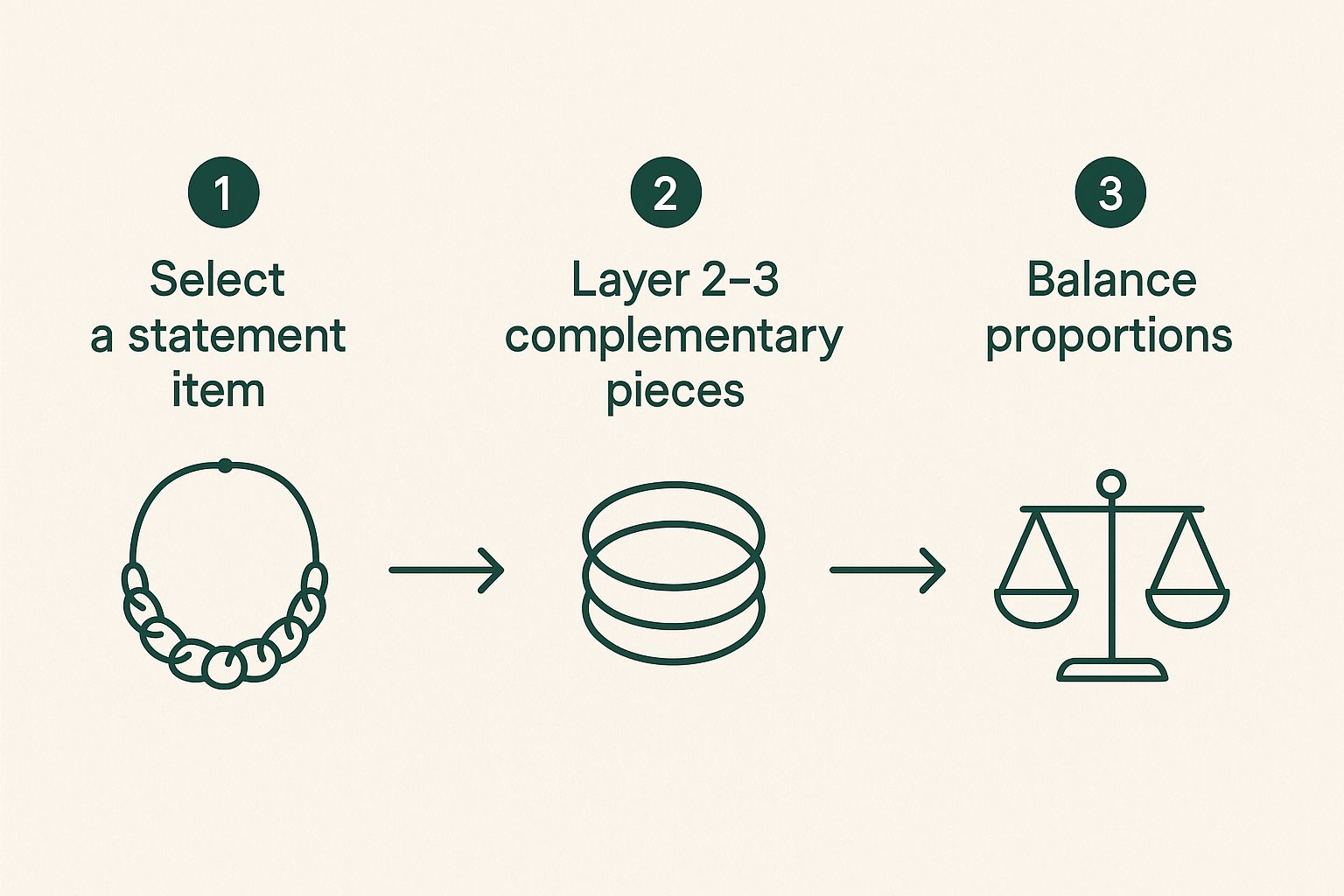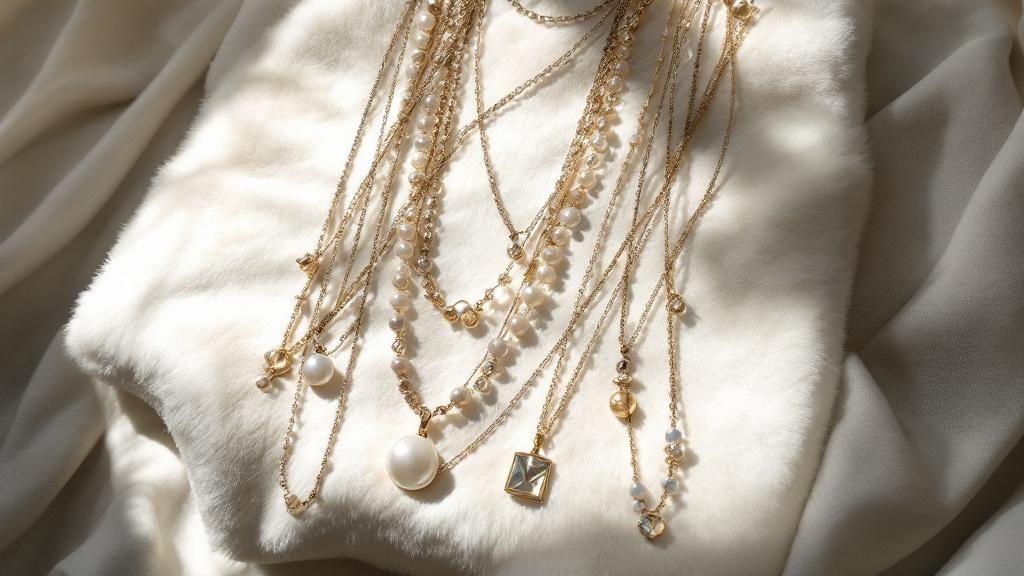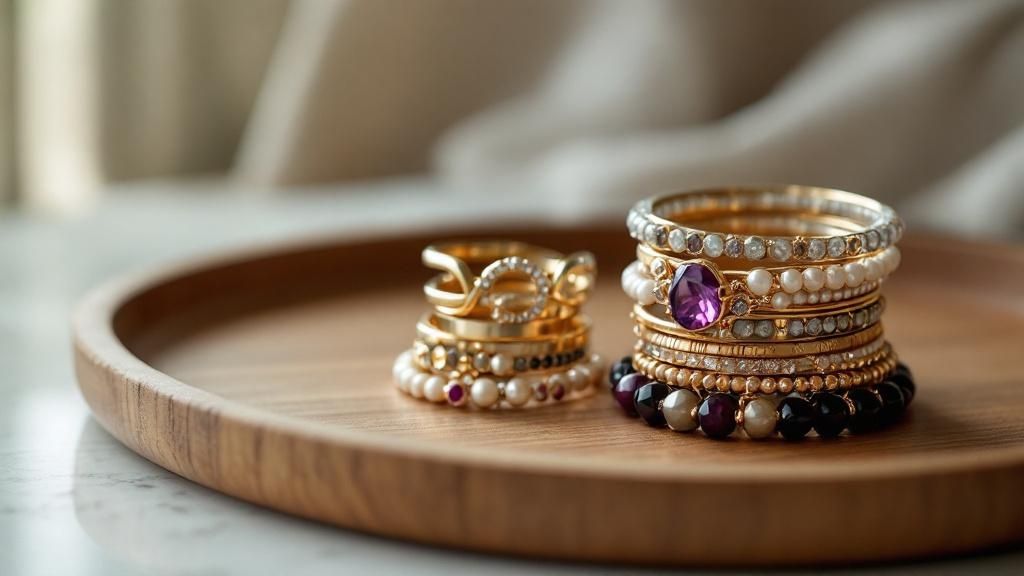- Continue Shopping
- Your Cart is Empty
How to Layer Jewelry and Curate Your Perfect Stack
Layering your jewelry is really more of an art than a science. It's all about playing with what you have to create a look that feels uniquely you. The idea is to combine a few necklaces, bracelets, or rings in a way that looks intentional, textured, and totally chic.
The secret isn't just piling on more pieces; it's about making them work together to tell a story. Getting this right can completely transform your accessories, breathing new life into old favorites and letting you express your personal style in a whole new way.
This move toward personalization is a big reason why layering has stuck around. As the global jewelry market continues to expand—it's expected to hit about $578.45 billion by 2033—more people are looking for creative ways to wear their collections. Once you get the hang of a few core ideas, you'll be able to build a stack for any outfit or mood.
Getting the Foundations Right
Think of building a layered look like putting together a great outfit. Each piece has a role to play, and the goal is to create a final result that feels balanced and interesting, not just busy.
Start with a Focal Point
Every great stack needs a "hero" piece. This is your main event—the piece that draws the eye and anchors everything else. It could be a necklace with a meaningful pendant, a chunky bracelet, or an eye-catching statement ring.
Once you have your hero, build around it with more delicate, complementary pieces. This approach keeps your look from feeling chaotic and ensures there's a clear star of the show.
Create Contrast with Textures and Metals
This is where the fun really begins. Don't be afraid to mix things up! Pair a smooth, slinky snake chain with a chunkier, more defined curb chain. The contrast in texture is what creates that rich, visually interesting depth.
The same goes for metals. Mixing gold, silver, and rose gold is no longer a fashion faux pas; it’s a modern way to add dimension. The key is to make it look deliberate. Try grouping metals by type—a stack of silver rings on one hand and gold on the other, or alternating metals in a bracelet stack.
Master the Spacing
For necklaces, this is everything. You absolutely have to vary your chain lengths to keep things from turning into a tangled mess. A good rule of thumb is to leave about 1 to 2 inches of space between each necklace. This gives every piece room to breathe and shine on its own.
For a deeper dive into finding that perfect spacing, our complete guide to necklace chain lengths is a fantastic resource. It'll help you visualize how different lengths fall and work together.
Before you start building your own looks, here's a quick cheat sheet on the core principles for layering necklaces, bracelets, and rings.
Core Principles of Jewelry Layering
| Principle | Necklaces | Bracelets | Rings |
|---|---|---|---|
| Focal Point | Start with a hero pendant or a standout chain to anchor the look. | Choose one bold cuff or statement piece as your centerpiece. | A single striking ring on your index or middle finger works best. |
| Vary Scale | Mix delicate, fine chains with heavier or chunkier styles. | Combine thin bangles, chain bracelets, and maybe a beaded style. | Pair delicate, minimalist bands with one or two larger rings. |
| Mix Textures | Combine smooth chains like snake or box chains with textured ones like rope or Figaro. | Mix metals, beaded bracelets, and leather or cord for contrast. | Stack smooth bands next to hammered, twisted, or engraved designs. |
| Create Space | Ensure 1-2 inches between each chain to prevent tangling and create visual separation. | Leave a little room for movement; don't pack them too tightly. | Distribute rings across different fingers and knuckles to avoid clutter. |
Remembering these simple guidelines will help you curate stacks that feel effortless and balanced every time.
The best-layered looks feel curated, not chaotic. Each piece should feel like it was chosen for a reason, working with the others to create a cohesive whole. It’s about telling your own style story.
Crafting the Perfect Necklace Stack
Putting together a beautiful necklace stack is an art. Done right, it takes an outfit from nice to perfectly styled. The secret isn't just throwing on a bunch of chains; it's about creating a look that’s balanced, personal, and tells a little story. The best way to start is by picking a "hero" piece.
This is your anchor, the necklace your whole look will revolve around. It could be a pendant that means something to you, a chunky chain that makes a statement, or a unique piece like this beautiful Poppy Field Necklace. Once you have your star, you can start building out from there.
My go-to rule for avoiding a tangled clump is to leave a 2 to 3-inch difference in length between each necklace. This little bit of breathing room lets every piece shine on its own.
Building Your Layers With Texture and Color
Once you've got the lengths figured out, the real fun begins: playing with textures. This is where you can add so much depth. Try mixing a slinky, smooth snake chain with something more textured, like a beaded or rope chain. That contrast is what makes a stack look interesting and thoughtfully put together.
This is why I love working with demi-fine jewelry. The quality is there, so you can build a collection of versatile, lasting pieces without the solid-gold price tag. If you're curious, you can learn more about what demi-fine jewelry is and see if it's right for your collection.

As you can see, it’s all about a simple process: start with one standout item, add a few complementary pieces around it, and then step back to make sure the whole look feels balanced.
Don't forget you can also bring in a little color! A pop of gemstone—maybe your birthstone or just a color you love—can tie your stack to your outfit and add that final, personal touch.
The goal is to be intentional. Start with your hero piece, give each layer its own space, and have fun mixing textures and even a hint of color. That’s how you create a necklace stack that feels uniquely you.
Building an Unforgettable Bracelet Stack
Ever wonder how some people create that effortless-looking "arm party"? It’s less about random piling and more about thoughtful curation. The secret is to build your stack around a single, standout anchor piece.
This could be your go-to watch, a sentimental cuff passed down from your grandmother, or that bold, chunky bracelet you splurged on. Whatever it is, this hero piece sets the tone for everything else you add, giving your stack a sense of purpose and keeping it from looking like a chaotic jumble.
Once your anchor is on, it’s time to play with texture and materials. This is where the real fun begins. Contrast is key. If your main piece is a sleek metal watch, try adding the organic feel of a leather wrap bracelet or the delicate sparkle of a few thin chains. This blend of different elements is what creates visual interest and gives your stack a unique personality.

This art of layering isn't new; it's a global practice with deep cultural roots. Just look at the Asia Pacific region, which according to the IMARC Group, held a massive 39.28% share of the worldwide jewelry market. In many Indian traditions, for example, brides and festival-goers layer dozens of gold bangles. This beautiful, maximalist approach has inspired fashion lovers everywhere to embrace a "more is more" philosophy.
Balancing Proportions and Color
Now, let's talk about getting the balance right. If you’ve chosen a substantial anchor piece, you’ll want to pair it with more delicate items. A wide, statement cuff, for instance, looks incredible next to a few whisper-thin bangles or a simple beaded bracelet. The idea is to create a dynamic interplay between different scales that feels harmonious, not overwhelming.
Color is your other superpower for tying the whole look together. You can guide your choices with a simple theme:
- Go monochrome: Stick to a single metal—all gold or all silver—for a timeless, polished vibe.
- Mix your metals: The key to making mixed metals look intentional is to wear at least two pieces of each. One silver piece in a sea of gold can look like an accident, but two or three creates a deliberate, cool-girl aesthetic.
- Add a pop of color: Weave in gemstone beads, a brightly colored cord, or an enamel piece that pulls a color from your outfit.
A great bracelet stack should feel like a collection of stories on your wrist. Mix textures, balance chunky with delicate pieces, and don't be afraid to let your personality shine through every choice.
Curating Your Ideal Ring Arrangement
Stacking rings is where you can really get creative and turn your hands into a personal style statement. It's about moving beyond just a single band and exploring the endless possibilities that come with blending delicate pieces and more substantial designs. The key is to create a look that feels balanced and uniquely you, not just cluttered.
Think of your hand as a blank canvas. One of my favorite strategies is what I call the pyramid approach. You start with a wider, more significant ring at the base of your finger and then stack smaller, more delicate bands above it. This creates a really nice visual taper that draws the eye upward.
Another go-to technique is the bookend method. This is perfect when you have one standout ring you want to feature. You simply place two similar, often simpler, bands on either side of it. Imagine framing a stunning pavé diamond band with two smooth, polished gold rings—it instantly makes your "hero" piece pop while creating a cohesive stack on that one finger.

Mix Metals and Textures
Don't be afraid to mix your metals! A combination of silver, yellow gold, and rose gold rings spread across your hand can add so much warmth and dimension. The trick to making it look intentional is to wear at least two pieces of each metal. It creates a theme.
In that same vein, play with textures. Try pairing a smooth, polished band right next to a hammered or twisted one. The contrast is subtle but makes a huge difference.
As you build your collection, think about how the pieces will physically fit together. Getting familiar with different engagement ring settings can be a huge help here, as it allows you to choose bands that sit flush against each other, avoiding those awkward gaps and ensuring a comfortable fit for all-day wear.
A well-balanced ring stack should feel harmonious, not heavy. I always suggest distributing rings across both hands and even leaving some fingers bare. This gives your statement pieces room to breathe and makes the whole look feel more collected and personal.
And don't forget about midi rings! These little gems, worn above the middle knuckle, are a fantastic way to add another layer without adding bulk. A delicate midi ring paired with a more substantial design on the same finger adds depth and a modern edge, perfectly completing your signature stack.
7 Common Jewelry Layering Mistakes (And How to Avoid Them)
Knowing how to layer your jewelry is one thing, but knowing what not to do is where the real artistry comes in. While there are no hard-and-fast rules—it’s all about your personal style, after all—a few common slip-ups can take your look from chic and curated to cluttered and chaotic. Let's walk through some of the most frequent mistakes I see.
The number one pitfall? Simply piling on too much. It's so easy to get carried away and add just one more piece, but this is usually what tips the scale. The goal is to find that perfect balance where your stack looks intentional, not accidental. If you feel weighed down or your jewelry is distracting from your outfit, you’ve probably gone a step too far.

Getting Proportions and Practicality Right
Another classic mistake is forgetting about proportion. A tiny, delicate pendant can get completely lost next to a super chunky chain. The two pieces end up competing for attention instead of complementing each other, which can look a little awkward. The key is to make sure the scale of your chains and pendants feels harmonious.
This same idea of balance applies to mixing metals. While I absolutely encourage mixing, an all-gold stack with one random silver piece can look like an afterthought. If you want to learn more about choosing the right materials for your layers, check out our guide on why 14k gold plated jewelry is so popular—it's a fantastic, durable option.
My Pro Tip: The ultimate goal is harmony, not a hot mess. If you find yourself constantly untangling your necklaces or adjusting your bracelets all day, it’s a clear sign the combination just isn't working from a practical standpoint.
Finally, a mistake that’s becoming more relevant is choosing pieces that don’t align with your values. With around 71% of couples under 35 prioritizing ethical sourcing, a truly curated look is about more than just aesthetics. It’s about feeling good about where your jewelry comes from.
A Few Final Questions on Layering Jewelry
Even with a solid game plan, you might still run into a few tricky situations. Nailing the answers to these common layering problems is often what separates a nice stack from a truly stunning one. Let's get into the questions I hear most often from people just starting to layer their jewelry.
Can I Really Mix Gold and Silver?
This is probably the number one question I get, and the answer is a huge yes! The old rule about sticking to one metal is long gone. Mixing gold, silver, rose gold, and other metals adds so much more personality and visual interest to your look. The trick is to make it feel intentional.
Here's my go-to rule for mixing metals: make sure you have at least two pieces of each. This simple guideline makes your combination look like a deliberate style choice, not an accident.
How Do I Stop My Necklaces From Tangling?
Ah, the dreaded necklace tangle. We’ve all been there. It’s incredibly frustrating when your beautifully layered chains turn into a knotted mess by midday. Thankfully, you can outsmart the tangle with a few simple tricks:
- Switch up the weights. Try pairing a really fine, delicate chain with something a bit heavier or more substantial. Chains with different weights and textures are far less likely to twist around each other.
- Give them some breathing room. I always recommend keeping at least a two-inch difference in length between each necklace. This ensures every piece has its own space to shine.
- Invest in a separator clasp. If you layer necklaces often, a separator is a game-changer. It's a small clasp with multiple loops that keeps each chain perfectly spaced and completely tangle-free all day long.
What’s the Magic Number? How Many Pieces Are Too Many?
While there isn't a single "right" answer, I do have some general guidelines that work for most people.
For necklaces, three or four is usually the sweet spot. When it comes to bracelets, you can often get away with more—try balancing one bolder statement piece with two to five more delicate ones. For rings, I find that spreading three to five rings across both hands creates a look that's interesting but not overwhelming.
Ultimately, the real test is how it feels. If your stack starts to feel clunky, heavy, or just too busy, you've probably hit your personal limit. It’s all about finding that perfect balance that feels authentically you.
Ready to build a stack that tells your story? At EFYTAL Jewelry, we handcraft beautiful, personalized pieces that are perfect for layering. Find your next favorite piece and start styling today at efytal.com.





